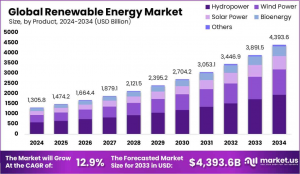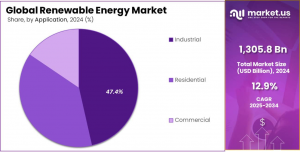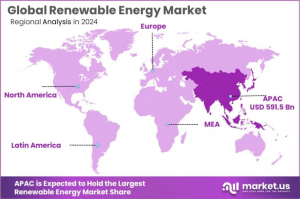Renewable Energy Market is expected to be worth around USD 4,393.6 Bn by 2034, up from USD 1305.8 Bn in 2024, and grow at a CAGR of 12.9% from 2025 to 2034.
In 2024, the Asia-Pacific region held 45.2% of the Renewable Energy Market, valued at USD 591.5 billion.”
NEW YORK, NY, UNITED STATES, January 22, 2025 /EINPresswire.com/ -- The global renewable energy market is experiencing a significant transformation, driven by a confluence of economic, environmental, and technological factors. This dynamic sector, pivotal for sustainable development, is characterized by rapid growth and innovation. Governments, corporations, and consumers increasingly recognize renewable energy as a key to addressing climate change and ensuring energy security, propelling the sector toward unprecedented expansion.— Tajammul Pangarkar
Currently, the renewable energy market is robust, with various energy sources such as solar, wind, hydro, and biomass making considerable strides. Solar and wind, in particular, lead the growth trajectory due to their scalability and increasingly favorable economics. The industry's expansion is further supported by global policies advocating for a decrease in carbon emissions and a shift away from fossil fuels. These policies have resulted in significant investments in renewable energy projects worldwide, from large-scale wind farms to decentralized solar photovoltaic systems. Moreover, technological innovations and economies of scale have led to a significant reduction in the cost of renewable technologies, making them more competitive with traditional energy sources.
The primary driving forces behind the surge in the renewable energy market include environmental concerns, technological advancements, and supportive government policies. The growing awareness of the detrimental impacts of fossil fuels on the environment and public health has catalyzed the shift towards cleaner alternatives. Additionally, governments around the world are offering various incentives such as subsidies, tax rebates, and feed-in tariffs to encourage the adoption of renewable energy. Technological advancements have also played a crucial role, enhancing the efficiency and storage capabilities of renewable energy systems, thereby increasing their attractiveness to both residential and commercial users.
The demand for renewable energy is escalating across all sectors. Residential consumers are increasingly adopting rooftop solar systems driven by the desire to reduce energy costs and minimize environmental impact. Commercial and industrial sectors are also transitioning towards renewable to mitigate operational risks associated with energy price volatility and to enhance their corporate sustainability profiles. Furthermore, the electrification of transport and heating is expanding the scope of renewable beyond traditional applications, promising further growth avenues.
Recent technological advancements are continually shaping the renewable energy market. Innovations such as floating solar panels and offshore wind turbines have opened new horizons for utilizing untapped resources. Developments in energy storage technologies, such as lithium-ion batteries and green hydrogen, are solving intermittent issues associated with wind and solar energy, thereby enhancing grid reliability and energy security. Digital technologies like blockchain and AI are also being integrated to optimize energy distribution and management, ensuring more efficient and transparent systems.
The future of the global renewable energy market is laden with opportunities. As technology continues to evolve and investment increases, the costs associated with producing and distributing renewable energy are expected to decline further. This trend is likely to make renewable energy more accessible in emerging markets, where energy demand is growing rapidly due to urbanization and economic development. Additionally, the push for net-zero emissions targets in various countries is set to open up new avenues for innovation in carbon capture and storage technologies alongside renewable deployments.
Curious about the content? Explore a sample copy of this report: https://market.us/report/renewable-energy-market/free-sample/
Key Takeaways
- Global Renewable Energy Market is expected to be worth around USD 4,393.6 Billion by 2034, up from USD 1305.8 Billion in 2024, and grow at a CAGR of 12.9% from 2025 to 2034.
- Hydropower dominates the renewable energy market, accounting for 44.3% share globally.
- On-grid renewable energy solutions lead, comprising 88.3% of total installations.
- The industrial sector drives renewable adoption, contributing 47.4% of market demand worldwide.
- In 2024, Asia-Pacific dominated the Renewable Energy Market with 45.2%, generating USD 591.5 billion.
Renewable Energy Statistics
- In 2022, renewable energy sources accounted for 29.1% of global electricity generation, totaling 8,440 TWh.
- Global renewable electricity generation is forecast to reach over 17,000 TWh by 2030, an increase of almost 90% from 2023.
- Global renewable energy capacity reached 3,865 GW by the end of 2023.
- Solar energy became the largest source of renewable capacity at 36.7% (1,418 GW), followed by hydropower at 32.7% (1,265 GW) and wind energy at 26.3% (1,017 GW).
Major Factors Driving the Growth of Renewable Energy Market
1. Environmental Concerns and Climate Change Initiatives One of the most significant drivers of renewable energy adoption is the growing awareness of environmental issues, particularly global warming and climate change. Governments and organizations worldwide are intensifying efforts to reduce carbon footprints and greenhouse gas emissions, prompting a shift towards renewable energy sources such as solar, wind, hydro, and biomass. This environmental imperative is further reinforced by international agreements like the Paris Accord, where countries have committed to limiting global temperature rise and transitioning towards cleaner energy sources.
2. Government Policies and Incentives Supportive government policies play a pivotal role in the renewable energy sector's expansion. Many governments offer incentives such as subsidies, tax breaks, and feed-in tariffs to encourage the development and adoption of renewable energy. These policies aim to make renewable energy more competitive against traditional fossil fuels and to stimulate market growth. Additionally, regulatory frameworks are being strengthened to support the integration of renewable energies into national grids, ensuring a smoother transition from conventional energy sources.
3. Technological Advancements and Cost Reduction Technological advancements are central to the growth of the renewable energy market. Innovations in photovoltaic technology, wind turbine design, energy storage solutions, and grid management technologies have significantly improved the efficiency and reduced the costs of renewable energy systems. As technology advances, the cost of generating renewable energy has dropped, making it more accessible and appealing to a broader range of consumers and industries.
4. Energy Security and Independence Energy security is a critical concern for many countries, driving the push towards renewable energy. By diversifying their energy sources and reducing dependence on imported fossil fuels, nations can enhance their energy security and gain greater control over their energy supply. Renewable energy, being largely domestic, reduces the geopolitical risks associated with energy trade and helps stabilize energy prices.
5. Corporate Responsibility and Consumer Demand There is a growing trend of corporate responsibility towards adopting green practices, including the use of renewable energy. Companies across various sectors are investing in renewable projects to enhance their sustainability credentials and appeal to eco-conscious consumers. Additionally, consumer demand for cleaner energy options has increased, driven by a broader societal shift towards environmental responsibility and sustainable living.
6. Economic Opportunities and Job Creation The renewable energy sector has become a significant source of economic growth and job creation. As investments in renewable energy projects increase, they generate new jobs in manufacturing, installation, and maintenance of renewable energy facilities. This not only boosts local economies but also supports global economic stability.
Key Market Segments
By Product Analysis
Hydropower leads the renewable energy market, holding a dominant 44.3% share in 2024. This significant share is attributed to hydropower's reliability and cost-effectiveness in generating electricity. The sector has benefited from substantial investments in large-scale hydroelectric projects, as well as the refurbishment of aging dams, which ensures a steady and predictable energy output. Due to its established infrastructure and proven capabilities, hydropower remains a preferred choice for many countries committed to expanding their renewable energy portfolios.
By Deployment Analysis
On-grid renewable energy systems dominate the market, accounting for a substantial 88.3% share in 2024. This is primarily due to the extensive development of grid infrastructure and the widespread use of renewable energy in urban and industrial areas. On-grid systems are favored for their lower installation costs and seamless integration into national electricity grids, making them an attractive choice for large-scale renewable energy projects.
By Application Analysis
The industrial sector is the largest consumer of renewable energy, accounting for 47.4% of the market in 2024. This is driven by the large-scale energy demands of manufacturing and processing industries, coupled with increasing pressure to adopt cleaner, more sustainable energy solutions. Industries are investing in renewable energy infrastructure to reduce their carbon footprints and meet stringent environmental regulations, making renewable energy a key component in modern industrial operations.
Key Market Segments List
By Product
-- Hydropower
-- Wind Power
-- Solar Power
-- Bioenergy
-- Others
By Deployment
-- On-Grid
-- Off-Grid
By Application
-- Industrial
-- Residential
-- Commercial
Regulations On Renewable Energy Market
1. Government Incentives: Governments worldwide are implementing various financial incentives to promote renewable energy adoption. These include tax credits, subsidies, and grants for renewable energy projects. These incentives reduce upfront installation costs and encourage private investments, making renewable energy more accessible to businesses and homeowners, and driving growth in the sector.
2. Renewable Energy Standards: Many countries have set Renewable Energy Standards (RES) that require a specific percentage of electricity to come from renewable sources. These mandates help boost the demand for renewable energy by ensuring utilities invest in clean energy technologies, thereby reducing reliance on fossil fuels and driving the transition to a low-carbon energy system.
3. Carbon Pricing and Emissions Targets: To combat climate change, carbon pricing mechanisms like carbon taxes and cap-and-trade systems are being introduced. These regulations make carbon emissions more expensive, creating financial incentives for industries to adopt renewable energy sources. Many nations have also set emission reduction targets, further encouraging the switch to clean energy alternatives.
4. Grid Access and Net Metering: Governments are implementing regulations that improve grid access for renewable energy sources. Net metering policies allow homeowners and businesses to sell excess renewable energy back to the grid, making renewable systems more economically attractive. These regulations enhance the integration of distributed energy sources and support the wider adoption of renewables.
5. Energy Efficiency Standards: Energy efficiency regulations are increasingly linked to renewable energy adoption. Governments are mandating energy-efficient building codes, appliance standards, and industrial practices. By improving efficiency alongside renewable energy deployment, these regulations ensure a more sustainable energy system while also lowering overall energy consumption and greenhouse gas emissions.
Elevate Your Business Strategy! Purchase the Report for Market-Driven Insights - https://market.us/purchase-report/?report_id=137872
Regional Analysis
1. Asia-Pacific's Leadership in Renewable Energy In 2024, Asia-Pacific dominated the renewable energy market, holding 45.2% of the global share and valued at USD 591.5 billion. This region's market leadership stems from rapid industrialization, strong government initiatives, and significant investments in renewable projects like solar, wind, and hydropower, especially in China and India.
2. North America's Renewable Energy Progress North America is a significant player in the renewable energy sector, led by the U.S. and Canada. This region is advancing due to federal and state incentives and ambitious goals for carbon neutrality, with substantial growth in offshore wind and solar PV installations. The U.S. alone represents over 23% of the global wind energy capacity.
3. Europe's Renewable Energy Commitment Europe continues to be a key contributor to the renewable energy landscape, driven by rigorous sustainability policies, carbon pricing, and the EU’s Green Deal, which targets a 55% reduction in emissions by 2030. Germany, the UK, and France are notably expanding their offshore wind and hydrogen energy projects.
4. Renewable Energy in the Middle East & Africa The Middle East & Africa (MEA) region is becoming increasingly attractive for renewable energy, utilizing its vast solar potential. Leading this are the UAE and Saudi Arabia with their large-scale solar projects.
5. Latin America's Renewable Energy Developments Latin America is experiencing growing adoption of renewable energy, particularly in Brazil and Chile. Favorable weather conditions and government incentives are boosting solar and wind energy capacities in these countries.
Key Players Analysis
- ABB
- Acconia S.A.
- Enel Spa
- General Electric
- Innergex
- Invenergy
- Schneider Electric
- Siemens Gamesa Renewable Energy, S.A.
- Suzlon Energy Ltd.
- Tata Power
- ACCIONA
- EDF Renewables
- Xcel Energy Inc.
- Enel Green Power S.p.A.
- National Grid Renewables
Conclusion
In conclusion, the global renewable energy market is poised for sustained growth, driven by a combination of regulatory support, technological innovation, and increasing consumer demand. As the world increasingly turns towards sustainable energy solutions, the renewable energy sector is expected to continue its upward trajectory, reshaping the global energy landscape and contributing to environmental conservation.
Lawrence John
Prudour
+91 91308 55334
Lawrence@prudour.com
Legal Disclaimer:
EIN Presswire provides this news content "as is" without warranty of any kind. We do not accept any responsibility or liability for the accuracy, content, images, videos, licenses, completeness, legality, or reliability of the information contained in this article. If you have any complaints or copyright issues related to this article, kindly contact the author above.




